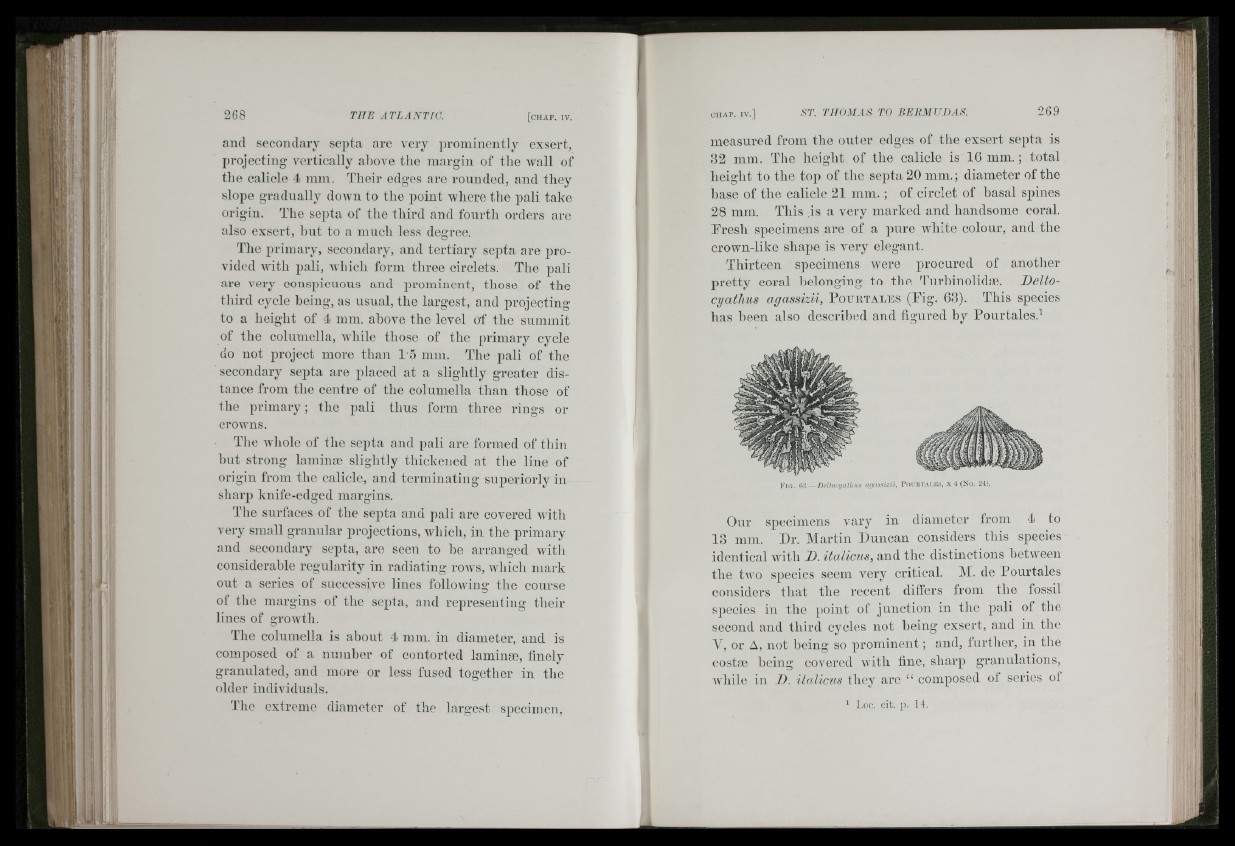
If G
and secondary septa are very ])rominently exsert,
projecting vertically above the margin of the wall of
the calicle 4 mm. Their edges are rounded, and they
slope gradually doAvn to the point where the pali take
origin. The septa of the third and fourth orders are
also exsert, hut to a much less degree.
The primary, secondary, and tertiary septa are provided
Avith pali, Avhich form three circlets. The pali
are very conspicuous and prominent, those of the
third cycle being, as usual, the largest, and projecting
to a height of 4 mm. ahove the level of the summit
of the columella, Avhile those of the primary cycle
do not project more than 1 5 mm. The pali of the
secondary septa are placed at a slightly greater distance
from the centre of the columella than those of
the primary; the pali thus form three rings or
croAvns.
The Avhole of the septa and pali are formed of thin
but strong lamina) slightly thickened at the line of
origin from the calicle, and terminating superiorly in
sharp knife-edged margins.
Tlie surfaces of the septa and pali are covered Avith
very small granular projections, Avhich, in the primary
and secondary septa, are seen to he arranged Avith
considerable regularity in radiating roAvs, Avhich mark
out a series of successive lines following the course
of the margins of the septa, and representing their
lines of groAvth.
The columella is about 4 mm. in diameter, and is
composed of a number of contorted lamina), finely
granulated, and more or less fused together in the
older individuals.
The extreme diameter of the largest sjiecimen.
measured from the outer edges of the exsert septa is
32 mm. The height of the calicle is 16 mm.; total
height to the top of the septa 20 mm.; diameter of the
base of the calicle 21 mm.; of circlet of basal spines
28 mm. This is a very marked and handsome coral.
Fresh specimens are of a pure Avhite colour, and the
crown-like shape is very elegant.
Thirteen specimens were procured of another
pretty coral belonging to the Turbinolidse. Belto-
cyatlius agassizii, P ourtales (Fig. 63). This species
has heen also described and figured hy Pourtales.'^
Î T
F i c . 6 2 — D d t o c ,y a t lM S a g a s s i z i i , P o u k t .u . e .?, x 4 ( N o . 2 4 ) ,
Our specimens A'ary in diameter from 4 to
13 mm. Dr. Alartin Duncan considers this species
identical Avith D. italicus, and the distinctions hetAveen
the two species seem very critical. AI. de Pourtales
considers that the recent differs from the fossil
species in the point of junction in the pali of the
second and third cycles not heing exsert, and in tlic
Aff, or A, not being so prominent; and, further, in the
eostie heing covered Avith fine, sharp granulations,
Avhile in I ) . ita lic A is they are “ composed of series of
^ Loc, cit. p. 14.
tel
■“*5
I 'I'
H; siA k.- -
I :;
(.3! -
Lis:
, :
'R-I
■ ; 0te- 1-